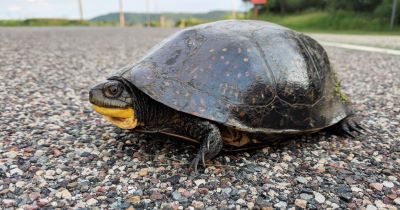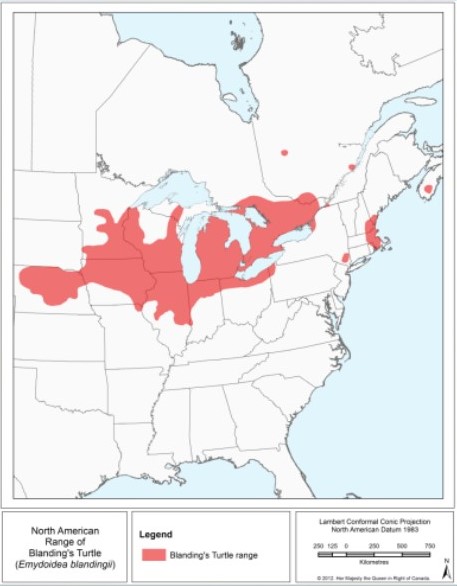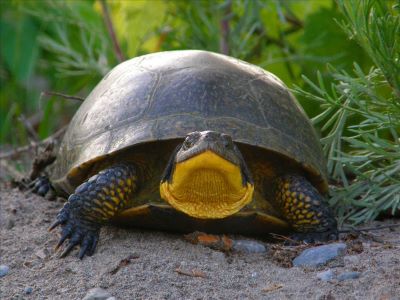Blanding's Turtle
Emydoidea blandingii, or commonly known as the Blanding's turtle, is a medium-sized, semi-aquatic turtle that inhabits freshwater wetlands in parts of the upper Midwest, New York, New England, and Southern Canada. The turtle is currently listed as threatened within the state of New York. The species' most notable features include a curved beak that resembles a smiling face and yellow freckled coloration on its carapace. The Blanding's turtle is considered a long-lived species with some individuals living past 83 years. The current threats to the Blanding's turtle include habitat & nesting destruction, due to urban sprawl, and vehicle strikes.

| |
| Kingdom: | Animalia |
|---|---|
| Phylum: | Chordata |
| Class: | Reptilia |
| Order: | Testudines |
| Family: | Emydidae |
| Genus: | Emydoidea |
| Species: | Emydoidea blandingii |
| Source: Blanding’s Turtle NYSDEC [1] | |
Description
The Blanding's Turtle is a medium-sized turtle species with an average shell length of approximately 7-10 inches and can grow to a weight of 4 lbs. The species has a distinctive yellow coloration on its throat and chin. The head and legs of the turtle also have a pale-yellow mottled appearance with its dark green skin. The turtle's beak has a characteristic curve upwards at the corners of the mouth, creating the appearance of a smiling face. The carapace, 'upper shell', is dome-shaped, with a flattened portion along the midline of the spine.[1] The coloration of the shell is black with a speckled pattern of yellow colored flecks and streaks that varies among individuals of the species. The plastron, 'belly plate' of the turtle, is dominantly yellow with dark blotches arranged in symmetrical patterns. The shape of the plastron is used to identify the sex of the turtles. Males are characterized by a concave plastron, while females have a flattened plastron. Like the Eastern Box Turtle, the plastron on the Blanding's Turtle has a hinged segment at the front, allowing the turtle to close off its front limbs and head from predators.
Habitat and Range
Habitat
The Blanding's turtle is a semi-aquatic species and inhabits water bodies with emergent, wet meadow vegetation. They prefer shrubby wetlands dominated by woody vegetation such as buttonbush and willow. Although it is not uncommon for the species to inhabit areas with vernal pools.[1] Other viable habitats include ponds, marshes, swamps, bogs, wet prairies, river sloughs, shallow embayments, and slow-moving rivers. Over winter, the turtle burrows in the soft sediment of the water body and covers themselves with mud and silt to reduce heat loss. During nesting seasons, the female turtle lays her eggs in open canopy dry upland areas with well-drained soils.[2]
Range
The species range encompasses the southern parts of the Great Lakes and extends from Minnesota to parts of southern Ontario and Northern New York. Few isolated populations have been identified in Dutchess County, Saratoga County, and the Thousand Islands Region along the St. Lawrence River within New York State. Other isolated populations have been identified in New England and Nova Scotia.[1]
Growth and Development
Comparable to sea turtles and tortoises, the Blanding's turtle is a long-lived species with a slow maturation rate. Some individuals of the species have been recorded living past 80 years of age. However, the species do not reach sexual maturity until 18 years of age and have low reproductive potential. The mating season occurs in April and parts of early May, with nesting occurring in early June. The female will leave the safety of the water to find a suitable upland habitat with spare canopies and moist, well-drained sandy or loamy soils. Nests are offended found in gardens, road embankments, and plowed fields. Females tend to lay a clutch of 4-18 eggs. Hatchlings emerge from late August to early October, and newly hatched turtles must make the journey to the nearest water body.
The Species is considered shy. When threatened, they will dive into the water and remain on the bottom for hours. If startled outside the water, the turtle will retreat into its shell and close it plastron to protect its forelimbs and head.
Over winter, the species will inhabit permanent water bodies and deep vernal pools. to prevent freezing and to minimize heat loss, the turtle will borrow into the sediment of the water body and cover itself with mud and slit.
Diet
The species is characterized as omnivorous and will scavenge in and around their water habitat. The majority of their diet consists of crustaceans, invertebrates, tadpoles, frogs, and aquatic plants. Some individuals have been recorded feeding off carrion, 'decaying animal matter', and catching live minnows.
Threats
As labeled by the State of New York Department of Environmental Conservation, the current conservation status of the Blanding's turtle is threatened. Problems facing the species include the destruction of habitat and nesting grounds from urbanization. Other issues include habitat fragmentation and vehicle strikes as a result of road crossings. The main threat to Blanding's turtle arises from vehicle strikes and habitat fragmentation. During nesting season, a female turtle will travel long distances, often more than a mile, in search of suitable vernal pool habitats. Because of their movement patterns, they require larger areas that often occur over urbanized landscapes. Road crossings are the biggest issue; their natural defense mechanism makes them highly vulnerable to vehicle strikes. In addition to its slow maturity rate and low reproductive potential, the loss of a breeding female becomes detrimental to the species. Throughout the Northeast, populations appear to be declining.
References
</refernces> 1. Blanding’s Turtle NYSDEC. Web. Accessed April 21, 2025 https://dec.ny.gov/nature/animals-fish-plants/blandings-turtle/ 2. Johnson, Glenn, et al. Distribution, Population Structure and Habitat Relationships of Blanding’s Turtle Populations in Northern New York. Endangered Species Unit, New York State Department of Environmental Conservation, 2009. 3. Adderley-Heron, Kelton, and Patricia Chow-Fraser. “Unsupervised Classification of Blanding’s Turtle (Emydoidea Blandingii) Behavioural States from Multi-Sensor Biologger Data.” PloS One, vol. 19, no. 11, 2024, pp. e0314291-, https://doi.org/10.1371/journal.pone.0314291. 4. Meng, Reta Lingrui, and Patricia Chow-Fraser. “Don’t Worry, Be Happy: Habitat Selection of Blanding’s Turtles (Emydoidea Blandingii) Living in a Reference Condition in Georgian Bay.” PloS One, vol. 18, no. 12, 2023, pp. e0295067–e0295067, https://doi.org/10.1371/journal.pone.0295067 5. Blanding’s Turtle (Emydoidea blandingii) U.S. Fish & Wildlife Service. December 18, 2024. https://www.fws.gov/species/blandings-turtle-emydoidea-blandingii.
- ↑ 1.0 1.1 1.2 "Blanding’s Turtle NYSDEC", Blanding's Turtle NYSDEC Open-File Report 2006-1195: Nomenclature", NYSDEC, n.d.. Retrieved 5/10/2025.
- ↑ "Emydoidea blandingii U.S. Fish & Wildlife Service", Open-File Report 2006-1195: Nomenclature", U.S. Fish & Wildlife Service, n.d.. Retrieved 5/10/2025.

